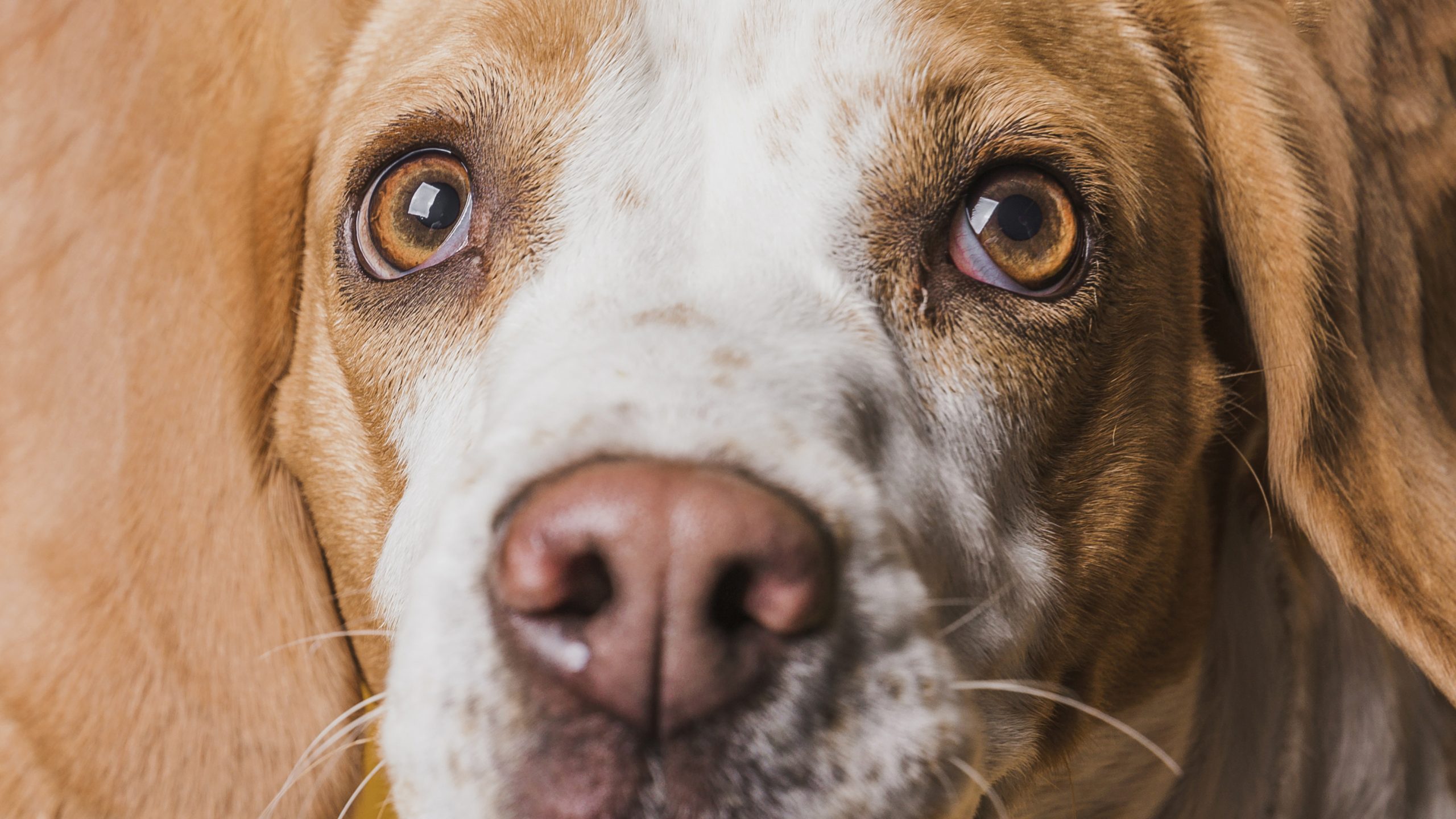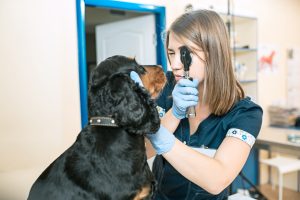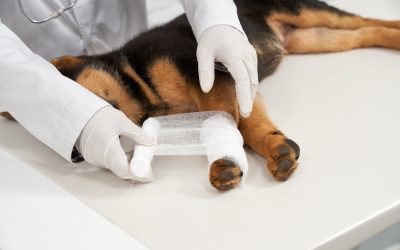Cataracts in Dogs: Get Rid of It Once and For All [Full Guide]

Canine cataracts are a common eye condition that can significantly impact a dog’s vision and quality of life. As pet owners, it’s essential to understand the causes, symptoms, and treatment options for this condition to ensure our furry companions receive the best possible care. In this comprehensive guide, we’ll explore the world of canine cataracts, providing you with the knowledge and tools to navigate this eye-opening journey.
What Is Cataract in Dogs?
A cataract is the clouding or opacification of the normally clear lens inside the eye. This lens is responsible for focusing light onto the retina, allowing the dog to see clearly. When a cataract develops, the lens becomes increasingly opaque, obstructing light from reaching the retina and ultimately leading to vision impairment or blindness.
Cataracts can occur in one or both eyes and range in severity from small, localized opacities to complete lens cloudiness. The onset and progression of cataracts can vary, with some developing gradually over time while others may appear suddenly.
Causes and Risk Factors of Canine Cataracts
There are several potential causes and risk factors associated with the development of canine cataracts, including:
- Genetics: Certain dog breeds, such as the Cocker Spaniel, Poodle, and Labrador Retriever, are predisposed to inherited or congenital cataracts.
- Age: Older dogs are more susceptible to age-related cataracts, with the condition becoming more common as dogs reach their senior years.
- Diabetes: Dogs with diabetes mellitus have a significantly higher risk of developing cataracts, often at a younger age.
- Trauma: Physical injury or trauma to the eye can lead to the development of cataracts.
- Radiation exposure: Certain types of radiation, such as those from diagnostic imaging tests, can contribute to cataract formation.
- Nutritional deficiencies: A lack of essential nutrients, such as vitamin E or selenium, may increase the risk of cataract development.
What Are the Stages of Cataracts in Dogs?
Canine cataracts typically progress through several distinct stages:
- Incipient Cataract: At this early stage, the cataract is small and localized, often appearing as a small, cloudy spot on the lens.
- Immature Cataract: As the cataract grows, it begins to occupy a larger portion of the lens, causing more significant vision impairment.
- Mature Cataract: The cataract has now fully developed, covering the entire lens and causing complete blindness.
- Hypermature Cataract: In this stage, the lens material begins to break down and liquefy, leading to additional complications, such as inflammation and glaucoma.
Signs and Symptoms of Canine Cataracts
The primary symptom of canine cataracts is a visible change in the appearance of the eye. Owners may notice:
- A cloudy or milky appearance in the affected eye(s)
- Difficulty seeing in low light or at night
- Behavioral changes, such as reluctance to jump or navigate familiar environments
- Increased sensitivity to glare or bright light
- Bumping into objects or hesitation when moving around
It’s important to note that the presence of cataracts does not always equate to complete blindness, as the severity and progression of the condition can vary.
How Does the Vet Diagnose Canine Cataracts?
Veterinarians use a combination of visual examination and specialized diagnostic tests to diagnose canine cataracts. The process typically involves:
- Comprehensive Eye Exam: The veterinarian will thoroughly examine the eye, using specialized instruments to assess the lens and detect any signs of cataract formation.
- Pupil Dilation: The veterinarian may dilate the dog’s pupils to view the lens and surrounding structures better.
- Ophthalmoscopy: This procedure involves the use of a specialized instrument called an ophthalmoscope to examine the interior of the eye, including the retina.
- Imaging Tests: In some cases, the veterinarian may recommend additional imaging tests, such as ultrasound or advanced imaging techniques, to gather more detailed information about the cataract and rule out other underlying conditions.
What’s the Difference Between Canine Cataracts and Nuclear Sclerosis?
It’s important to distinguish between cataracts and nuclear sclerosis, another age-related eye condition. While both can affect the appearance of the lens, they are distinct conditions with different causes, implications, treatments, and management approaches.
Nuclear Sclerosis:
- A natural, age-related hardening and yellowing of the lens
- Usually occurs in older dogs and is not considered a disease
- Does not significantly impact vision
Cataracts:
- A clouding or opacification of the lens
- Can occur at any age and is a progressive, degenerative condition
- Leads to vision impairment or blindness if left untreated
What Are the Treatment Options for Canine Cataracts?
The treatment options for canine cataracts can be broadly categorized into two main approaches: non-surgical management and surgical intervention.
Non-surgical Management:
- Dietary Supplements: Some studies suggest that certain dietary supplements, such as antioxidants and omega-3 fatty acids, may help slow the progression of cataracts.
- Eye Drops: While there is no definitive cure for cataracts using eye drops, some medications may help manage symptoms and delay the need for surgery.
- Vision Aids: Devices like special lenses or goggles can help enhance the dog’s remaining vision and improve their quality of life.
Surgical Intervention:
- Cataract Surgery: This is the most common and effective treatment for advanced cataracts. The procedure involves removing and replacing the clouded lens with an artificial intraocular lens (IOL).
- Posterior Capsulotomy: In some cases, a secondary procedure called a posterior capsulotomy may be performed to address complications after cataract surgery.
The decision to pursue surgical or non-surgical treatment options will depend on factors such as the severity of the cataract, the dog’s overall health, and the veterinarian’s recommendation.
Optimal Management Approaches for Cataract Complications
In some cases, complications may arise during or after the treatment of canine cataracts. These complications can include:
- Glaucoma: Increased pressure within the eye, which can lead to further vision loss.
- Retinal Detachment: Separation of the retina from the underlying layer, potentially causing permanent vision impairment.
- Inflammation: Ongoing inflammation in the eye, which can exacerbate the condition.
Veterinarians may employ various management strategies to address these complications, such as:
- Medication: Prescription eye drops or oral medications to control pressure, reduce inflammation, and prevent further vision loss.
- Specialized Procedures: Additional surgical interventions, like a posterior capsulotomy or glaucoma management, to address specific complications.
- Ongoing Monitoring: Regular check-ups and close follow-up care to ensure the dog’s eyes remain healthy and the condition is properly managed.
Eye Removal (Enucleation)
In some rare cases, the affected eye may need to be surgically removed (enucleation) if the cataract has led to severe complications, such as intractable pain or complete vision loss. This procedure is typically a last resort when all other treatment options have been exhausted.
Enucleation can provide relief from discomfort and prevent further complications, but it is a significant decision that should be made in consultation with the veterinarian, considering the dog’s overall well-being and quality of life.
Debunking Eye Drops for Cataracts
There are currently no over-the-counter products, such as eye drops or topical medications that can effectively treat or reverse the progression of cataracts in dogs. While some drops may provide temporary relief or slow the condition’s advancement, they are not a cure.
Consult with a veterinary ophthalmologist to determine the appropriate treatment plan. Depending on the severity of the cataract, this may include prescription medications, dietary supplements, or surgical intervention.
Living with a Canine with Cataracts
Caring for a dog with cataracts requires patience, understanding, and a commitment to their well-being. Here are some tips for supporting a canine companion with this condition:
- Adapt the Home Environment: To help the dog navigate safely, modify the home, such as adding contrast markers, removing obstacles, and providing ample lighting.
- Maintain Consistent Routines: Stick to familiar routines and environments to minimize confusion and disorientation.
- Provide Enrichment and Exercise: Engage the dog in activities that stimulate their other senses, such as scent work, and ensure they receive appropriate exercise to maintain their physical and mental well-being.
- Offer Emotional Support: Spend quality time with your dog, providing comfort, affection, and reassurance to help them adapt to their changing vision.
- Seek Professional Guidance: Work closely with your veterinarian to develop a comprehensive care plan and explore all available treatment options.
Prevention and Care
While not all cases of canine cataracts can be prevented, there are steps pet owners can take to minimize the risk and provide the best possible care for their furry companions.
- Responsible Breeding Practices: Breeders should screen for genetic predispositions to cataracts and selectively breed dogs with healthy eyes to reduce the incidence of inherited cataracts.
- Regular Veterinary Check-ups and Eye Exams: Routine veterinary visits, including comprehensive eye exams, can help detect cataracts in the early stages, allowing for timely intervention and management.
- Maintaining a Healthy Lifestyle and Appropriate Nutrition: Providing a balanced, nutrient-rich diet and ensuring the dog maintains a healthy weight can support overall eye health and potentially slow the progression of cataracts.
If your dog is showing signs of vision changes or you suspect they may be developing cataracts, don’t hesitate to schedule an appointment with your veterinarian. Early detection and proper management are key to preserving your furry friend’s eyesight and overall quality of life. Take the first step towards understanding and addressing canine cataracts today.
Cost of Treating Canine Cataracts
The cost of treating canine cataracts can vary widely, depending on the severity of the condition, the treatment approach, and the location of the veterinary care. On average, the cost of cataract surgery for dogs can range from $2,5000 to $4,000 per eye. Additional costs may include pre-operative testing, medications, and post-operative care.
It’s important for pet owners to discuss the estimated costs with their veterinarian and explore any available financing options or pet insurance coverage that may help offset the expenses.
How Can Pet Insurance Help You if Your Dog Has Cataract?
Pet insurance can be a valuable tool in managing the costs of treating dog cataracts and other veterinary expenses. By having a pet insurance policy in place, you can have peace of mind knowing that you can provide medical care for your furry companion without worrying about the financial burden. Pet insurance can help cover the costs of veterinary consultations, diagnostic tests, medications, and even specialized treatments if required.
Reimbursement
This method is the most common for pet insurance companies. You pay out of pocket for the veterinarian bill, and then the insurance company reimburses you for what’s covered under the insurance plan. The steps look like this.
- You pay the vet bill after your dog’s visit.
- You fill out the pet insurance claim form.
- Submit the claim form and other required documentation to the insurer.
- After the claim is approved, you will be reimbursed for eligible expenses.
What Does Odie Pet Insurance Cover?
Pet insurance covers various veterinary expenses, providing financial protection and peace of mind for pet owners. Here are the details of the coverage options offered by Odie Pet Insurance:
Illness & Injury Plan
The Illness & Injury Plan is an all-inclusive insurance plan designed to cover a wide range of medical needs for your pet. This plan includes comprehensive coverage for various illnesses, injuries, and veterinary services. Some of the covered items include:
- Veterinary exams and consultations
- Diagnostics (e.g., X-rays, lab tests)
- Prescribed medications
- Surgeries and hospitalization
- Rehabilitation, acupuncture, or chiropractic treatments
- Medically necessary supplies
- Euthanasia and cremation
The Wellness Plan
The Wellness Plan is a monthly membership that focuses on preventive care and covers routine veterinary services.
- Provides reimbursements for routine care items such as wellness visits (exams and vaccines), testing and parasite prevention, dental cleanings and at-home dental care, vitamins, supplements, and more.
- Through Odie’s partnership with Petivity, a leader in smart pet products and proactive care, Wellness Plan members can also receive reimbursements for Petivity devices and health kits, as well as eligible Purina food and supplements.
- Total reimbursement up to $700 per year.




